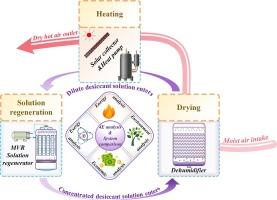Energy, exergy, environmental and economic analysis of a solar-assisted heat pump-driven enclosed drying system with liquid desiccant dehumidification
IF 9.9
1区 工程技术
Q1 ENERGY & FUELS
引用次数: 0
Abstract
Drying process, as one of the most energy-intensive processes, plays a significant role in a variety of agricultural, residential and industrial applications. Existing solar or heat pump drying systems have not been well promoted and applied due to their instability or inefficiency. In order to achieve a stable and efficient drying process, a novel solar-assisted heat pump-driven enclosed drying system with liquid desiccant dehumidification is proposed in this study, in which total waste heat recovery structure and operation modes transition control strategy are carefully designed for better system performance. A comprehensive analysis incorporating energy, exergy, economic, and environmental assessments are performed based on established mathematical models. Results demonstrate that the proposed system achieves a maximum coefficient of performance of 7.84, an energy utilization ratio of 11.09, and a specific moisture extraction rate of 14.87 kg/kW·h when solar radiation exceeds 640 W/m2. Exergy analysis further reveals that over 80 % of exergy loss occurs in the solar collector, with the system attaining an exergy efficiency of 50.1 %. When annual solar radiation values reach 1580 kW·h/m2 and 1300 kW·h/m2, the system reduces electricity consumption by 36.64 % and 29.82 %, respectively, compared to traditional cascade enclosed heat pump drying systems, achieving a payback period of approximately 5 to 18 months. Additionally, the novel system cuts annual CO2 emissions by 27.65 % compared to conventional drying methods, highlighting its significant environmental benefits.

带液体干燥剂除湿的太阳能辅助热泵驱动封闭式干燥系统的能源、放能、环境和经济分析
干燥过程是最耗能的过程之一,在各种农业、住宅和工业应用中发挥着重要作用。现有的太阳能或热泵干燥系统由于其不稳定性或低效率而没有得到很好的推广和应用。为了实现稳定高效的干燥过程,本研究提出了一种新型的太阳能辅助热泵驱动的液体干燥剂除湿封闭式干燥系统,其中精心设计了总余热回收结构和运行模式转换控制策略,以实现更好的系统性能。根据已建立的数学模型,对能量、放能、经济和环境评估进行了综合分析。结果表明,当太阳辐射超过 640 W/m2 时,拟议系统的最大性能系数为 7.84,能量利用率为 11.09,比湿提取率为 14.87 kg/kW-h。放能分析进一步表明,超过 80% 的放能损失发生在太阳能集热器上,系统的放能效率为 50.1%。当年太阳辐射量分别达到 1580 kW-h/m2 和 1300 kW-h/m2 时,与传统的级联封闭式热泵干燥系统相比,该系统的耗电量分别减少了 36.64% 和 29.82%,投资回收期约为 5 至 18 个月。此外,与传统干燥方法相比,该新型系统每年可减少 27.65 % 的二氧化碳排放量,凸显了其显著的环境效益。
本文章由计算机程序翻译,如有差异,请以英文原文为准。
求助全文
约1分钟内获得全文
求助全文
来源期刊

Energy Conversion and Management
工程技术-力学
CiteScore
19.00
自引率
11.50%
发文量
1304
审稿时长
17 days
期刊介绍:
The journal Energy Conversion and Management provides a forum for publishing original contributions and comprehensive technical review articles of interdisciplinary and original research on all important energy topics.
The topics considered include energy generation, utilization, conversion, storage, transmission, conservation, management and sustainability. These topics typically involve various types of energy such as mechanical, thermal, nuclear, chemical, electromagnetic, magnetic and electric. These energy types cover all known energy resources, including renewable resources (e.g., solar, bio, hydro, wind, geothermal and ocean energy), fossil fuels and nuclear resources.
 求助内容:
求助内容: 应助结果提醒方式:
应助结果提醒方式:


